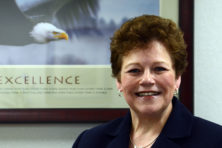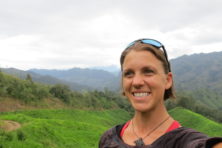Connecting and Supporting Our Schools: Alumni Door County
- Share
- Tweet
- Pin
- Share
More than 1,100 high school students are walking the halls of Door County’s schools this year. By the time the lilacs are blooming, about a quarter of them will be preparing to graduate and then begin postsecondary education, join the military or enter the job force. The county’s five districts — from north to south, Washington Island, Gibraltar, Sevastopol, Sturgeon Bay and Southern Door — cover 2,370 square miles: a distance that’s nothing to sniff at. Now a new organization, Alumni Door County, seeks to promote and support them all.
“Alumni Door County started as a conversation within the [Door County] Community Foundation about what our students lack in Door County,” said Bret Bicoy, Door County Community Foundation president and CEO. “Our public schools do a fine job with the resources they have, but they face significant limitations due to their lack of scale.”
Bicoy’s apt assessment of the limitations of rural school districts everywhere underpins the need to find ways to connect and boost these districts’ resources, both capital and human.
“Alumni Door County fills a dual role of helping our alumni thrive and generating financial resources to expand and extend education opportunities for our students who will one day become the next generation of our alumni,” Bicoy said.
Although Alumni Door County’s goals can — on the surface — be boiled down to money and networking, they are truly much deeper and broader. Door County graduates grapple with common desires and challenges as they wade into the adult world: Should I pursue a degree? Near or far? Should I continue working at my summer job to maintain the cash flow? Should I travel? Take a gap year? Get job training? At the heart of many of these students’ plans, though, is the central question of whether they see themselves staying in the county in the immediate future.
Polly Alberts, past chair of the Door County Foundation and owner of Alberts Plastering, Inc. calls herself a “willing participant” in getting the organization off the ground.
“It’s a hole in the community that needs to be filled,” Alberts said. “So many of our kids head off to get their education and don’t have a good path back. [Alumni Door County] can be all about making those connections.”
According to David Eliot, chair of Alumni Door County, “We have a big brain drain [in Door County]. How do we stop that? We can stop it — or we can embrace it, and say part of this is that with your Door County education, you can go on to do great things. Yes, we’d love you to stay, but we also encourage you to grow elsewhere, and if you do grow elsewhere, come back and share what you’ve learned with the community that helped you get there.”
According to a May 2018 Pew Research Center report, between 2000 and 2015, a majority of rural counties saw a population decline, including 68 percent of Midwest counties. And although the goal of Alumni Door County is not necessarily to keep more Door graduates in the county, it does aim to connect those who have stayed with those who have departed to bolster career networking.
How those graduates get connected is what Alumni Door County is actively working on, and one of its first plans is to create a website as a resource to connect graduates.
“It’s also to be able to show the people who are in school now, you can graduate from here and do this: whether it’s start your own tech company, move to a different country, stay in the community and build your own business, Eliot explained. “There’s not enough of a connection between graduates and student bodies. Teachers can do that a little bit, but there’s nothing formalized, and there’s nothing to do a search and see who’s gone on to become an English professor, for example, who can come back and talk in a class.”
It also provides an avenue for employers in the county to connect with graduates, wherever they may be in the country.
“We have connections to all kinds of businesses here — manufacturing, construction — and I hear all the time about these great jobs that don’t get filled,” Alberts said. “This would be a way to connect our graduates to those openings.”
Alumni Door County also wants to streamline the ways in which graduates can contribute financially to the schools where they got their start. Most colleges and universities have robust alumni networks that garner substantial funds. Creating a unified model of giving for the five county schools is a good place to start.
“There should be more private money in public education,” Eliot said. “If you look at education as a whole, and even at what public universities are doing, they go after private dollars constantly, and there’s no ask for any money for any [public] schools, K – 12, in the state of Wisconsin. There are some private campaigns that take place instead of referendums.”
Thus far, Alumni Door County has the support of all five district superintendents as long as any revenue streams don’t interfere with or replace community referenda. The organization is simply seeking ways in which private dollars could finance experiences or purchase equipment.
“Of course, it is neither realistic nor our goal to replace the public revenue we commit to education,” Bicoy said. “The core functions of schools — such as teacher salaries, textbooks and basic facilities — should always be the responsibility of the taxpayers. We hope to use private philanthropic resources to help provide opportunities for our young people to excel.”
Alumni Door County is also attempting to make it simpler for graduates to donate to schools, potentially giving to all five or just one of their choice.
“There’s not a big push to go after people who have graduated to give back to their community for it,” said Eliot. “I know in Door County there have been people who have tried to give money to the schools, but it’s hard. It’s not easy. And there should be an easy way to do that, and there should be an easy way to connect with the people who have graduated from the school.”
Ultimately, the idea would be that through unifying resources, students could gain access to information and experiences they may otherwise have missed. There are some Door County school programs such as sports teams and student-government experiences that are already cooperating, but Alumni Door County seeks to do more.
“When you aggregate the need and demand, you sometimes have the ability to offer a program or service that is beyond the reach of any individual school district,” explained Bicoy. “Alumni Door County follows that same logic. There isn’t likely enough demand to sustain an alumni program for any one of Door County’s school districts. What we’re exploring now is if, when we aggregate that demand from across five districts, can we then build and sustain an alumni program that can serve us all.”
Alumni Door County is very much in its fledgling stage. Its board of advisers has been working toward a goal of raising $350,000 to set up the project for future success, but there is still work to be done before it can be officially launched.
“In the future, I don’t want to say that the possibilities are endless, but they kind of are. Once it gets rolling it will make a real difference for the community,” Alberts said.
With articulated goals to support a worthy cause, Alumni Door County seems well on its way to becoming an integral thread in the fabric of the community.
Visit doorcountycommunityfoundation.org/alumni-door-county for more information.





